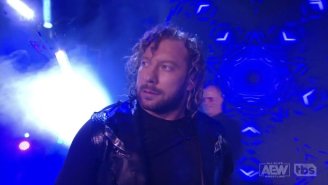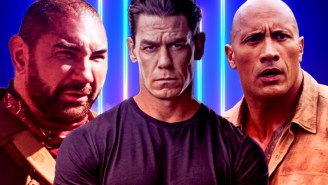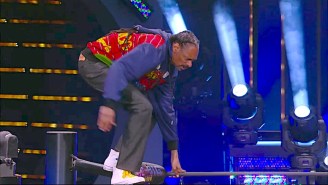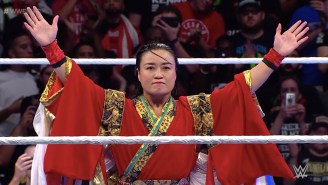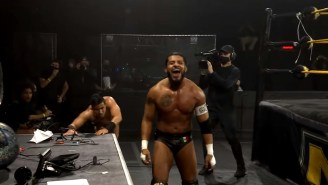On Friday, WWE will present its annual Hall of Fame induction ceremony. Kurt Angle will headline this year’s class, and he will be joined by fellow honorees Diamond Dallas Page, Rick Rude, Teddy Long, The Rock ‘n’ Roll Express, and Beth Phoenix, as well as Warrior Award recipient Eric LeGrand. But a new wrinkle to the Hall of Fame, which was established last year, is the Legacy wing.
The Legacy wing of the WWE Hall of Fame serves to honor the pre-television history of professional wrestling (or at least, the pre-modern era of professional wrestling), as a means both to pay tribute to the fact that the art form has been around and been extremely popular for well over 100 years, and to further legitimize the modern inductees that contemporary fans are familiar with.
Last year’s inductees were Mildred Burke, Frank Gotch, Georg Hackenschmidt, Ed “Strangler” Lewis, Pat O’Connor, Lou Thesz, and “Sailor” Art Thomas. You may not be familiar with the batch of names that will be added to the Legacy wing in 2017, so we’re here to help you out.
Farmer Burns
Farmer Burns, along with previous Legacy inductees Frank Gotch, Georg Hackenschmidt, and Ed “Strangler” Lewis, is often viewed as one of the pillars of professional wrestling as we know it. He had his first professional bout in 1880 at the age of 19, after spending years in amateur wrestling, and inventing, innovating, or perfecting the art of catch wrestling. His style allowed the pinfall to come from pretty much anywhere, which is a tactic that Daniel Bryan employed as his key to victory for a time during his Ring of Honor days.
Burns was undefeated from 1890 until 1893, and in 1895 he captured the unified American Heavyweight Championship by defeating Evan “Strangler” Lewis (not to be confused with Ed “Strangler” Lewis; this was a different Strangler altogether). He was the fourth champion in this title lineage, and held the title for two years.
After Burns’ retirement in the late 1890s, Burns opened a school in Illinois and taught his particular style of catch wrestling to a score of pro wrestlers who would be massive stars in the early 20th century, including none other than Frank Gotch.
His feats of strength and his massive neck are the stuff of legend. He would perform a stunt at carnivals and fairs wherein he would be outfitted with a noose and dropped from a height of six feet, while managing not to be killed. He did this all the time, and please take a minute to think about how completely insane that is.
The “Farmer Burns workout” that he developed is still practiced by some amateur wrestlers, strongmen and assorted Crossfit types. His renown as a trainer even got him a gig as a conditioning coach for Jim Jeffries before the boxer’s 1910 championship fight against Jack Johnson.
Dr. Jerry Graham
https://youtu.be/dY7YjT4RLV8?t=2m59s
The founder of the Graham wrestling family, Dr. Jerry Graham (real name Jerry Matthews) was actually Vince McMahon’s favorite wrestler when the WWE CEO was a teen, and his heel antics no doubt left a lasting impression on Vince. There is no real explanation, however, for why his 1985 appearance on Tuesday Night Titans (seen above) had him coming out to a keyboard cover of Bruce Springsteen’s “Dancing in the Dark.”
Graham debuted in 1947, and had an extended feud with Buddy Rogers in the 1950s. His most infamous moment came in 1957, when he and tag team partner Dick the Bruiser caused a riot in Madison Square Garden during a match against Argentina (Antonino) Rocca and Edouard Carpentier. A wrestling riot was pretty standard stuff in the ’50s, but eight police officers were injured in the fracas, and Dick the Bruiser was banned for life by the New York State Athletic Commission.
Graham’s wrestling family included “Superstar” Billy Graham, Eddie Graham, and Mike Graham. Jerry’s many title reigns included four stints as NWA United States Tag Team Champion, a WWWF United States Tag Team Championship, and twice becoming the NWA Southern Heavyweight Champion in Mid-South.
You can also check out Graham in action in his younger years, including really getting the crowd riled up with some mid-match water bottle antics.
Haystacks Calhoun
Calhoun is pretty unarguably this year’s Legacy inductee whose name is most well-known to American wrestling fans. Billed at 663 pounds by the time he was in his early 20s, Calhoun legitimately worked on the family farm before getting recruited into the wrestling business in 1955.
Initially competing under the name Country Boy Calhoun, he popularized the tropes of “hillbilly wrestler” and — for lack of a better term — “fat guy wrestler” that exist to this very day. After he appeared on a nationally-broadcast television show showing off his inhuman strength by flinging bales of hay into a loft, the moniker “Haystacks” stuck for good. At this point, he adopted his now-iconic attire of overalls and a real horseshoe on a chain around his neck, which would later be lifted by everyone from Hillbilly Jim and Uncle Elmer to the Godwinns and probably some people in Impact Wrestling that I’m forgetting.
The heaviest wrestler in the world at the time, he was so popular throughout the 1960s and 1970s that the term “Haystacks” for a gentleman of certain proportions entered the popular consciousness and lexicon, and never left. He also helped popularize the trope of tag team partners of significantly different proportions and styles, as he held the WWWF tag title with Tony Garea, and was NWA United States Tag Team Champion with Jack Brisco.
Haystacks retired in the early 1980s and was confined to his home in 1986 after losing his left leg to diabetes. He passed away in 1989 at the age of 55.
Luther Lindsay
Breaking into the business in the early 1950s after a championship amateur wrestling career and two years playing in the Canadian Football League, Lindsay became one of the earliest major African-American wrestling stars, and while training extensively with Stu Hart, became one of the few men who ever bested the Hart Family patriarch.
Lindsay (real name Luther Goodall) was held in the highest esteem by his peers, and he wrestled all the way into the 1970s, winning championships all over the world, including a tag team title reign in All Japan, and a slew of NWA titles in both the United States territories and in Canada.
Tragically, Lindsay holds the unfortunate distinction of having died in the ring. During a match against Bobby Paul in Charlotte on February 21, 1972, Lindsay — as near as can be determined — suffered a fatal heart attack after a splash, and died atop Paul while making the pin. He was taken to the locker room and declared dead shortly afterward.
Rikidozan
It is perhaps impossible to overstate the importance of Rikidozan (Mitsuhiro Momota) within Japanese pro wrestling (or puro resu, if you’re nasty). He emigrated from his native Korea and was adopted by the Momota family before making his debut as a professional sumo wrestler, where he was given the sumo ring name of Rikidozan. He achieved the rank of sekiwake before leaving sumo for professional wrestling, likely due to discrimination against Korean sumo wrestlers within Japan.
He made his pro wrestling debut in 1951, and — immediately after World War II, mind you — became Japan’s biggest star by defeating a slew of visiting American wrestlers. Of course, he was always a foreign heel when he traveled to America to wrestle, but in his adopted homeland, there was no bigger national hero in the sport.
Rikidozan became a worldwide name when he captured the NWA International Heavyweight Championship in 1958 by defeating none other than Lou Thesz. He would continue to capture championships all over the globe, and somehow still found the time to train both Antonio Inoki and Giant Baba, two of the biggest stars the wrestling world has ever seen. As I said, it’s hard to overstate Rikidozan’s influence and legacy. If that weren’t enough, two of his matches — against Thesz in 1957, and against The Destroyer in 1963 — are in the top ten most-watched Japanese television programs of all time.
Rikidozan’s story also has a tragic end, unfortunately. In December of 1963, he was stabbed with a urine-soaked blade by a Yakuza member in a Tokyo nightclub. He refused to get medical attention for his wound (or at least, he did not seek immediate attention, according to which account you read), and it became septic. He died a week later of peritonitis caused by the stabbing.
The motives for the attack have never been officially confirmed, but the most common story is that the stabbing was retaliation for Rikidozan breaking a pre-match agreement with Msahiko Kimura (inventor of the Kimura, if you can believe it) and shooting on him after an errant low blow. Rikidozan’s killer spent seven years in prison after being convicted of manslaughter.
June Byers
DeAlva Eyvonnie Sibley (possibly the greatest shoot name of all time) broke into the business as June Byers in 1944, when Mildred Burke and Mae Young were already established main event stars within the women’s circuit.
Byers steadily gained popularity and had a breakthrough match when she wrestled Burke to a one-hour time limit draw in 1954, up 1-0 in a two out of three falls match. Since this was the age of intense kayfabe, the Atlanta Athletic Commission later awarded the victory to Byers, along with the NWA World Women’s Championship. Yes, an actual, legal, governing body weighed in on how the one-hour draw would be put down in the record books. Amazing.
Burke and Byers held bad blood with one another over the decision, and Burke created the WWWA World Championship for her own promotion out of protest, and continued to bill herself as the World Women’s Champion. Byers held the NWA title until announcing her intent to retire in 1956, at which point she was stripped of the belt by the Baltimore Athletic Commission. Athletic commissions: always triflin’.
Fabulous Moolah, of course, won the vacant title, and Byers came out of retirement to unsuccessfully challenge for it. She moved to the St. Louis territory and continued to wrestle until a lingering leg injury from a car accident forced her into retirement in 1964 at the age of 41. She later became a real estate agent and had two children, and passed away from pneumonia in 1998 at the age of 76.
Here is Byers in action against Penny Banner:
Judy Grable
A student of Moolah’s, Grable made her debut in 1953 and was called “The Barefoot Contessa” because of her penchant for eschewing in-ring footwear. No one tell Ina Garten. Born Nellya Baughman, Grable started out as an acrobat for Ringling Brothers, before quitting to go into the much safer business of professional wrestling.
Grable was popular in the NWA territories in the ’50s and ’60s, but is arguably most famous for her appearance on Groucho Marx’s What’s My Line? She retired from full-time wrestling in 1966 after marrying, and came back for a match in 1974 before quitting again for good. She has a daughter who also became a wrestler and works under the name Debbie Grable.
Judy passed away in 2008 at the age of 72.
Toots Mondt
Likely the only “Toots” who will ever enter the Hall of Fame, James Ervin Mondt’s in-ring career spanned four decades, and his influence as both a wrestler and promoter is pretty important, given that he co-founded the World Wide Wrestling Federation with Vince McMahon, Sr. after Capitol Wrestling Corporation excised itself from the NWA in 1963.
Toots — who had booked the NWA world title reign of Buddy Rogers prior to the split — came up with the “tournament in Rio de Janeiro” fabrication that crowned Rogers the first-ever WWWF World Heavyweight Champion, creating a lineage all the way to the WWE Championship currently held by Bray Wyatt. Mondt is also credited with convincing Vince Sr. to build the company around Bruno Sammartino — a gamble that paved the way for everything else in modern pro wrestling history to follow.
Of course, his in-ring career was no less influential. He began his pro career in 1912, and later joined up with Ed “Strangler” Lewis’ group after Farmer Burns himself put in a good word for him. As the popularity was beginning to thin due to the 1910s tradition of long, shoot-style bouts, Toots and Lewis developed a new style of wrestling that was shorter and more flashy, and the two men, along with Billy Sandow, began promoting the hell out of themselves and their group. They eventually became known as “The Gold Dust Trio,” and are credited with creating the first true pro wrestling promotion, as we would recognize it today.
Mondt sold off his share of WWWF in the mid-1960s after gambling debts put his back up against the wall. He continued to gamble away pretty much everything he had before passing away in 1976 when he was 82 years old.

